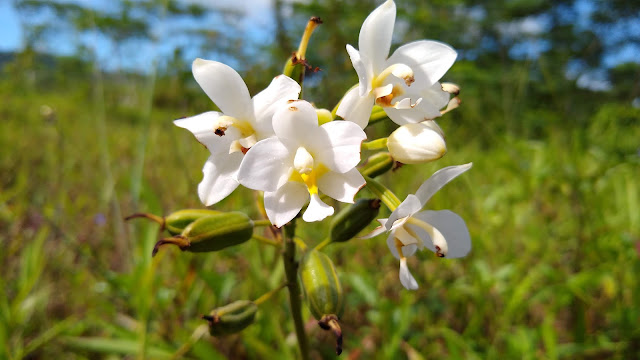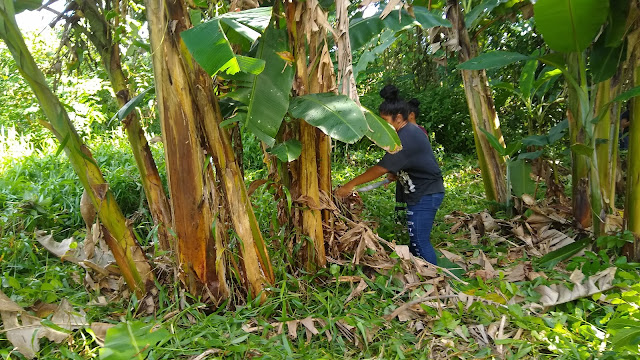Assessing Learning in Ethnobotany
SC/SS 115 Ethnobotany proposes to serve three program learning outcomes through two course level outcomes. The course serves learning outcomes in general education and the Micronesian studies program.
The twenty-three students (8 female, 15 male) who completed the course engaged in a number of activities in support of this learning outcome. Reproductive strategies were also communicated via student presentations. Morphology was supported by a vegetative and floral morphology walk along with a fruit type identification exercise. Identification of local plants permeated every outing, field trip, and hike.
The final examination involved a walk on campus and required the students to identify twenty-two local plants. The students had to identify the plants by Latin binomial, local name, and provide a specific cultural use for the plant. The students had a list of 89 Latin binomials for plants found on and around the Paies, Palikir, campus to assist with the Latin name identification. An online flora for the campus is available to the students.
Collectively, the 21 students who took the field final examination made 383 correct Latin binomial identifications out of 462 possible identifications for a 83% success rate, up slightly term-on-term. Rain shifted the route of the final spring 2019, the plants that appeared on the spring final were a more challenging and difficult list of plants than in prior terms. The uptick was a return to the longer term average performance.
The course also includes self-tests on the plants of the campus built into the Schoology Learning Management System in use on campus. The students can take these self-tests an unlimited number of times, after each time the system shows the students the correct answers. The high score on the test is retained as part of the student's grade, providing incentive to take the test repeatedly until the mark the student desires is achieved.
Students engaged in presentations on healing plants, plants as food, plants used for material culture.
For the twenty-two plants on the final examination, the 21 students were collectively able to cite 418 uses out of 462 possible uses, a success rate of 90%. This was up insignificantly against past performance.
This will be the last term that students will have worked with bananas from production on the land to the kitchen to the table as seen in the Chuukese feiren uuch image from class above.
| PLO | SC/SS 115 CLO |
|---|---|
| GE 3.4 Define and explain scientific concepts, principles, and theories of a field of science. | 1. Identify local plants, their reproductive strategies, and morphology. |
| GE 4.2 Demonstrate knowledge of the cultural issues of a person’s own culture and other cultures. MSP 2 Demonstrate proficiency in the geographical, historical, and cultural literacy of the Micronesian region. | 2. Communicate and describe the cultural use of local plants for healing, as food, as raw materials, and in traditional social contexts. |
CLO 1
Identify local plants, their reproductive strategies, and morphology.The twenty-three students (8 female, 15 male) who completed the course engaged in a number of activities in support of this learning outcome. Reproductive strategies were also communicated via student presentations. Morphology was supported by a vegetative and floral morphology walk along with a fruit type identification exercise. Identification of local plants permeated every outing, field trip, and hike.
Twenty-one of the twenty-three students attended the field final examination exercise. One student had stopped attending class after the midterm, the other student was still attending the course but was absent for the final examination.
The final examination involved a walk on campus and required the students to identify twenty-two local plants. The students had to identify the plants by Latin binomial, local name, and provide a specific cultural use for the plant. The students had a list of 89 Latin binomials for plants found on and around the Paies, Palikir, campus to assist with the Latin name identification. An online flora for the campus is available to the students.
Performance on Latin name, local name, and local use sections of the final exam
Collectively, the 21 students who took the field final examination made 383 correct Latin binomial identifications out of 462 possible identifications for a 83% success rate, up slightly term-on-term. Rain shifted the route of the final spring 2019, the plants that appeared on the spring final were a more challenging and difficult list of plants than in prior terms. The uptick was a return to the longer term average performance.
Flora review practice in Schoology
The course also includes self-tests on the plants of the campus built into the Schoology Learning Management System in use on campus. The students can take these self-tests an unlimited number of times, after each time the system shows the students the correct answers. The high score on the test is retained as part of the student's grade, providing incentive to take the test repeatedly until the mark the student desires is achieved.
CLO 2
Communicate and describe the cultural use of local plants for healing, as food, as raw materials, and in traditional social contexts.
Awak Farmers Association Areca catechu leaf sheaf petiole plates
For the twenty-two plants on the final examination, the 21 students were collectively able to cite 418 uses out of 462 possible uses, a success rate of 90%. This was up insignificantly against past performance.
Ethnogardening
Changes in arrangements and personnel on campus, the desire to find space in the curriculum for integrating the use of iNaturalist technology into the course, and increasing safety concerns over student capabilities with machetes led to this term being the last term to work in the banana patch. Of the three reasons, safety was the prime concern. Over the past few terms I have observed that students are less aware of how to safely and securely use a machete in small spaces. Although I have long enjoyed working with the class in the field, and this work has made the class unique and different, the skills and capabilities of the students are shifting and changing. Today my students are more skilled with a smartphone than a machete.
Students engaged in a final field work exercise in the banana patch
Chuukese feiren uuch
This will be the last term that students will have worked with bananas from production on the land to the kitchen to the table as seen in the Chuukese feiren uuch image from class above.
Performance on the final examination across multiple terms
Over time performance on the final examination had been generally improving. The current format dates back to spring 2009, although in 2011 and 2012 additional questions were added to the final examination. Since spring 2013 the format of the final examination has remained essentially the same. The addition of plants to the campus and to the final has made the final more challenging with each term. This term the number of plants to be identified increased to twenty-one plants.
Long term final examination success rates
From 2002 to 2005 the course had a course content oriented final examination. From 2005 to 2008 the course ended with a final essay examination (not included above). As noted above, spring term 2009 the course shifted to using the present format of naming plants and explaining their uses in a field final practical examination.
In the spring 2009 final there were twelve plants on the final and a list of only 20 Latin binomials. By the spring of 2010 the number of plants to be identified increased to 16 plants of a possible 26 plants on the Latin name list. The averages seen in the spring and fall of 2010 are in part a function of the ethnobotanical garden having been a small collection of 26 plants in one corner of the campus at this time.
Spring 2016 the final examination expanded to include 20 plants and a list of 72 Latin names. Each term the number of plants listed in the Latin names list has increased, this term 89 plants were on the list, up six from spring 2019. The number of plants on the Latin names list is also the number of plants the students are attempting to learn during the term. Some students already know the local names of their plants, but many students are unfamiliar with the name in their language of plants around them.
In the spring 2009 final there were twelve plants on the final and a list of only 20 Latin binomials. By the spring of 2010 the number of plants to be identified increased to 16 plants of a possible 26 plants on the Latin name list. The averages seen in the spring and fall of 2010 are in part a function of the ethnobotanical garden having been a small collection of 26 plants in one corner of the campus at this time.
Spring 2016 the final examination expanded to include 20 plants and a list of 72 Latin names. Each term the number of plants listed in the Latin names list has increased, this term 89 plants were on the list, up six from spring 2019. The number of plants on the Latin names list is also the number of plants the students are attempting to learn during the term. Some students already know the local names of their plants, but many students are unfamiliar with the name in their language of plants around them.
Part of the increase in the number of plants is due to the intentional evolution of the campus and environs as a living herbarium. The final examination has become increasingly difficult, challenging, and comprehensive. The final examination is an authentic assessment that would make sense to any member of the community - the ability to walk through the landscape of an island, identify plants and describe uses is the very definition of ethnobotany.










Comments
Post a Comment